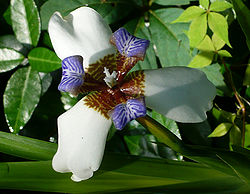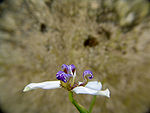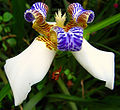Walking iris
| Walking iris |
|---|

|
| Scientific Classification |
|
| Binomial Name |
|
Neomarica gracilis |
| Image Description |
The Walking iris is a species of iris known by the scientific name Neomarica gracilis. It is not actually a member of the genus Iris, but it is very closely related [1]. Its also known by the common names, Apostle Plant and Twelve Apostles, which are derived from the observation that a Walking iris won't bloom until it has 12 leaves [2]. The leaves are said to represent the disciples of Jesus and the main stalk with flowers is a representation of Jesus [3]. It is native to southern Mexico and Brazil. The Brazilians called this plant 'Marica' [4].
Anatomy
The flowers of Neomarica gracilis are fairly fragrant, with white flowers with mottled crimson-brown and a blue-violet banding [5]. The yellow structure in the middle of the flower contains three branches of each of the style, each style branch bearing not very noticeable stigmatic zones at their tips [6]. It grows to a height anywhere from 18 inches to 36 inches and a spread of 18 inches to 24 inches per plant. The flowers last only a day but will bear flowers multiple times from late spring into the fall. Neomarica gracilis or Walking Iris is a pretty subtropical recurring plant with a rhizomatous, clumping growth habit. Apostle Plant has lovely flat, lime green foliage in a sword-like shape [7]. The 2 inch flower is on a free moving soft stem that can reach 3 ft in length, drooping down and away from the stiff, shiny, sword-shaped leaves that are 2 by 3 inches [8].
Reproduction
In spring, the Walking iris produce a lightly fragrant blue and white flower that was produced on a long stalk, which is shadowed by seed capsules [9]. The fragile flowers last only a day but the plant continues to form new blooms for long periods of time during the late spring months. Once the flower is exhausted, the stem that was born lies to the ground and from that a new plant is formed. For that reason it is said to be walking across your garden. You can divide plants and plant them in new locations [10]. It spreads from rhizomatous roots and from plantlets formed on the leaves after the flower is gone; these plantlets walk towards the ground and forms root and can be easily removed and propagated. The Walking iris grows best in well-drained soil that is acidic and is in a semi shady location. It loves high humidity and enjoys being misted on hot summer days [11]. A clump of walking iris may be separated, but the spread from fresh seed is easy and fairly fast. Plants mature to flowering size from seed in less than a year [12]. The blooms will usually be visible when the Walking iris is two years of age. Often in a fast growing situation or warmer regions, this will happen in about one year. The best growing situations are when it goes from sunny to half shady, especially if it gets the morning sun. Good drained soil is required, although the plant can tolerate a moist situation. Spreading is very easy. After each bloom air roots, a small plant will grow. Either set the plant in a 4-inch pot of soil still attached to the mother plant or snip and re-pot. Both methods work find. Even water rooting may work. Keep the plant moist and wait until the plant is pot bound before moving it up to the next pot size [13].
Ecology
In colder areas, the Walking Iris can also be cultivated in a container and brought indoors during winter. The perennials are fairly easy to grow and require low maintenance [14]. The Walking iris is attracting to bees, butterflies and birds [15]. also all parts of this plant are poisonous if ingested. It’s a good idea to discourage your pets from nibbling on Neomarica to avoid any gastrointestinal effects [16].
Other
The Walking Iris was discovered in Brazil near the ocean in some shady sandy soil. It will grow in full sun but its color is best in the light shade and when it is water regularly. The best case seems to be when it is in moist, well drained soil in locations were the morning sun can get it, but still have the shade in the afternoon. [17] Neomarica gracillis plantlets can be easily dug up and planted or just let them be to form a lovely mass. [18] Normally the blossoms last for only a day, but each flower cluster, or inflorescence, bears several flowers, which bloom on consecutive days [19].
Gallery
 Browse |
References
- U.S. Department of Agriculture. Author. Publisher. Date
- eBioNews 12/29/2006
- WALKING IRISES Jim Conrad. December 13, 2009
- Flowers of India
- Neomarica caerulea TopTropicals Plant Catalog
- Aluka
- Apostle Plant Plant Care
- Walking Iris, Apostle Plant







